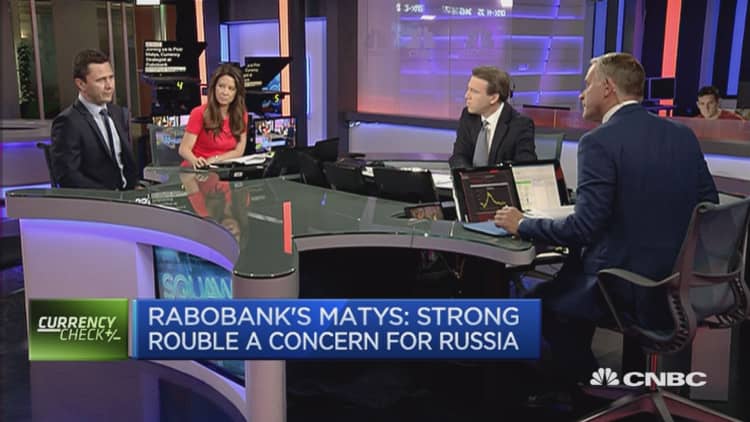
This week's fluctuations in oil prices and their impact on the world's stock markets may have investors worried but some analysts have pointed out a strong correlation between the commodity and emerging market currencies.
Commodity importing countries such as India and Indonesia have benefitted from lower oil prices whereas exporting countries such as Russia and Brazil suffered a major blow. And now, with oil prices rebounding this week, the Russian ruble is getting some relief.
The ruble is one of the top performing emerging market currencies this year, rising more than 12 percent against the U.S. dollar.
Oil vs. Rouble
Piotr Matys, Currency Strategist at Rabobank says this is because of the strong correlation between oil and the ruble.
"If you look at the correlation between the oil and ruble, that correlation is quite strong. So the initial thought is it is about oil," Matys told CNBC Friday.
"But it is not only that, the ruble befitted from the rebound in oil prices and also the fact that it is one of the highest-yielding EM currencies right now with the key interest rate at 10.5 percent."
Matys further explained that the Russian currency and the Brazilian real are examples of currencies that have benefitted from strong demand for high-yielding currencies since the start of the year.
Is $50 the magic number?
The Indian rupee for instance has been under pressure ever since the oil prices saw a rebound. India is one of the largest importers of oil in the world with imports nearing 80 percent of its total oil needs. This accounts for one third of its total imports. Thus a fall in price would drive down the value of its imports helping India narrow its current account deficit.
Over the past four years, oil - which is dependent on China as its top global consumer, has seen prices go down to below $35 a barrel. But analysts have forecasted $50 a barrel as the magic number for crude oil. Mihir Worah, CIO of real return and asset allocation at Pimco told CNBC last month that the right price for oil is in the "fifties."
"We think the right price over the next couple of years — we are pretty close to the right price — is in the fifties. That is where supply and demand gets balanced."
WTI Crude is up nearly 27 percent since the start of the year, while Brent Crude is up more than 31 percent. These prices have seen a lot of volatility on fears of global supply glut, China's economic growth and skepticism over an unlikely freeze deal among major oil producing countries. The prices got a boost on Thursday evening, jumping more than 4 percent, their strongest day since April following a surprisingly large drawdown in U.S. crude stocks as Gulf Coast imports slumped to a record low.
"While the decline in inventories is believed to be due to temporary factors, it was enough to briefly push Brent crude back above $50 and while we're seeing a small correction today, the upward pressure may remain in the short term," Craig Erlam, senior market analyst at Oanda told CNBC via email.


